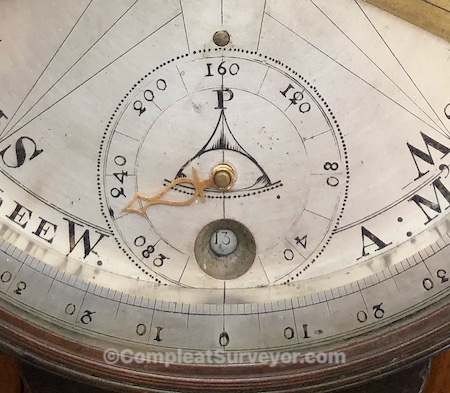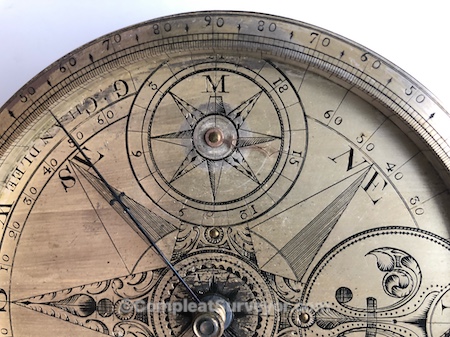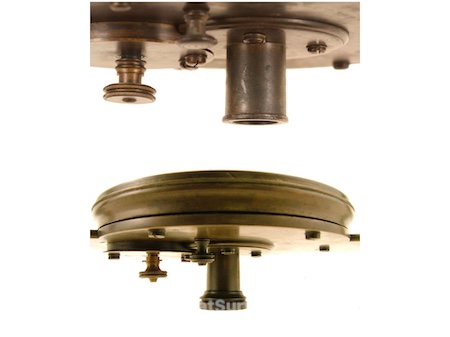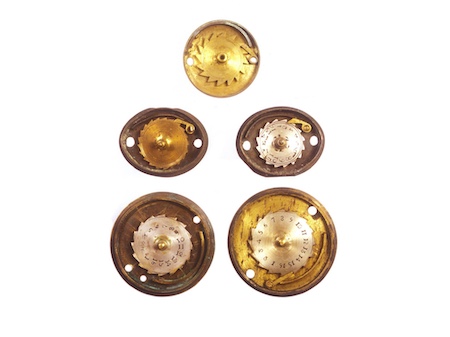The Wonderful and Unique Goldsmith Chandlee Poles & Mileage Counters
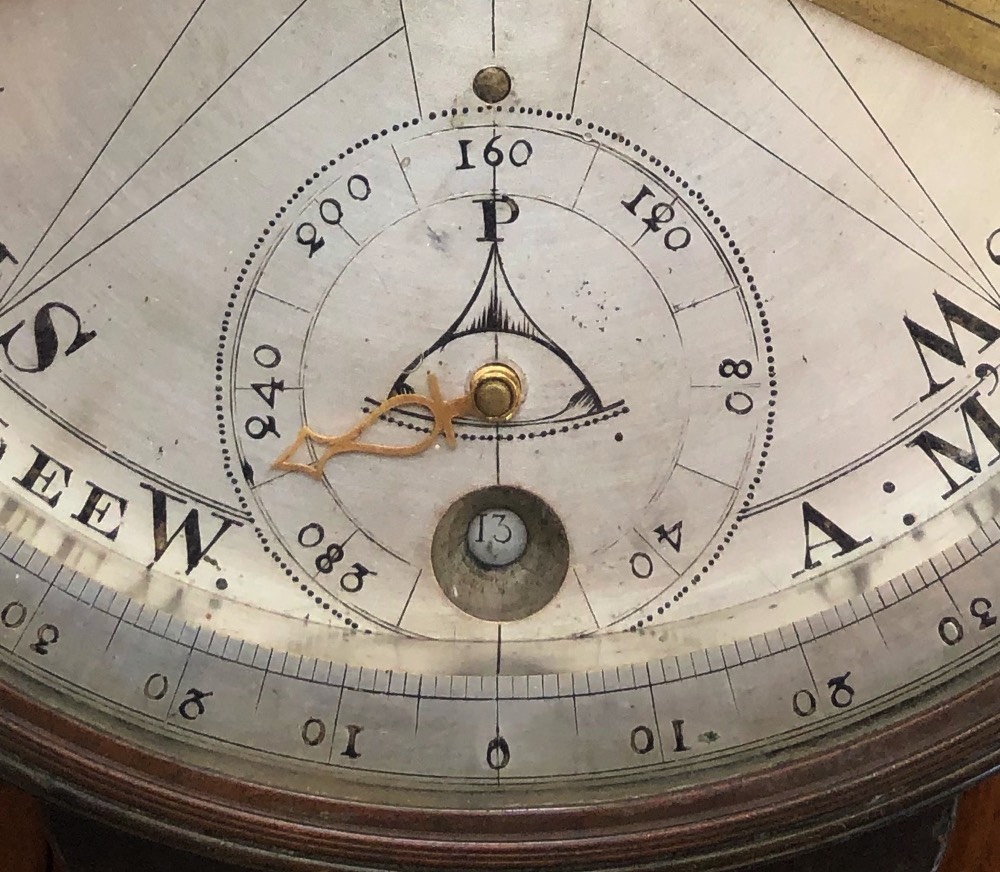
GC's Famous Poles/Perches Counter
Goldsmith Chandlee's Counters - Poles and Miles
Goldsmith Chandlee placed an outkeeper on his compasses like none other. But first, what's an out? "Out!" is what the head chainman yells when he is out of chaining pins. Perhaps I should digress. Chaining is performed using eleven chaining pins. When a distance is to be measured, the head chainman starts off with ten chaining pins on a ring. The eleventh pin is used to mark the beginning point of the distance to be measured. The rear chainman has no pins on his chaining pin ring. The distance of the chain or tape is laid off, the head chainman placing a chaining pin from his ring at the end (or some mark) of his chain, and yells "Stuck!" when the chaining pin is in the ground. On hearing "stuck" the rear chainman pulls his chaining pin and places it on his ring. Once the chain is again ready (straight, pulled tight, horizontal) the rear chainman yells "Good!" and the head chainman places another chaining pin in the ground and again yells "Stuck!" Again, on hearing that, the rear chainman pulls his chaining pin and places it on his ring. And so the chaining progresses. Note that using this procedure, the number of chain units measured, or, the location of the chaining pin in the ground, equals the number of chaining pins the rear chainman has on his ring. For example, if the crew is using a 66-foot chain and the rear chainman has eight chaining pins on his ring, then the pin in the ground is at eight chains from the beginning point. The chaining progresses until, after sticking the last chaining pin on his ring, the head chainman yells "Out!" (out of chaining pins) which is an explanation of the "out" mentioned above. It's ten pulls of the tape or chain, whatever is its length.
The early instructions for the survey of the public lands called for the use of a two-pole chain (33 feet). An "out" (ten pulls) would therefore be 20 poles (330 feet). The usual outkeeper found on most compasses by practically all makers, from the late 1700s until as late as the 1940s, shows the integers 1 through 16. As the head chainman yelled "Out!", the compassman clicked the outkeeper another unit until the number 16 was reached. At that point the chainman had measured 16 outs, or, if using a two-pole chain, 320 poles (2 poles x 10 x 16), or one mile.
Goldsmith Chandlee was not satisfied with an outkeeper that merely counted from 1 to 16. He apprenticed to his father, Benjamin, Jr. who was a noted clock and instrument maker. Because Goldsmith was a clockmaker himself, the development of an elaborate outkeeper was easily within his ability.
The outkeeper that Goldsmith Chandlee invented and developed had no equal. Chandlee's outkeeper is operated from the bottom of the compass. As the knob is advanced, the integers 1 through 16 can be viewed through a window as seen from above the compass. At the same time the knob advanced, a pointer or hand moved to point to the numbers 0 through 320, engraved on the face of a dial in 20-unit increments. So, as the number of "outs" is counted from 1 through 16, the dial/hand arrangement converted the "outs" to poles. Thus we had our first automatic data collector, which is so popular in today's electronic/computerized world of surveying.
No other maker used this advanced form of outkeeper, and we may be able to attribute the invention of the outkeeper in general to Chandlee. An informal examination by the authors of known early (pre-1800) American compasses shows only Goldsmith Chandlee placing an outkeeper on a compass—with one exception: there is a Benjamin Rittenhouse compass which is dated 1786 that has a simple 1-16 outkeeper. Chandlee began crafting compasses somewhere between 1775 to 1783.
Actually, Goldsmith Chandlee had two forms of outkeepers or counters on some of his compasses. One, as described above, which is labeled with a prominent "P" (poles) on its dial. The other is a more simple dial operated by a knob (on the underside of the compass) that turned a hand on the compass face. The dial, prominently marked "M" (miles) is graduated in single units from 0 through 21, and is marked in units of 3: 3, 6, 9 … 21. Using this counter, the surveyor could count the miles surveyed. Choosing the increment of 21 miles seems peculiar because 21 miles is not indicative of any land division in the U.S. Public Land Survey System. Of course when this counter was invented, the Public Land System was in its infancy, "An Ordinance for Ascertaining the Mode of Locating and Disposing of Lands in the Western Territory" was passed by the Continental Congress on May 20, 1785. (This "Ordinance of 1785" began what we know today as our system of sections, townships and ranges, or the U.S. Public Land Survey System.)
It seems that Goldsmith's less elaborately engraved and decorated compasses only have the one "P" (poles) outkeeper. His more extravagant compasses have both the intricate "P" outkeeper and the "M" counter.
The above is quoted verbatim from The Professional Surveyor (Dick Elgin) - On Goldsmith Chandlee (2001) A really good article on GC.
Chandlee Articles
Here are some helpful reference materials related to the Chandlee Family of Instrument Makers:
1. Chandlee - Six Quaker Clockmakers (1943).
2. American Backcountry Tall Clock - Goldsmith Chandlee - His Genius His Customers (2016) A must see article that focuses on clocks and compasses.
3. The American Surveyor (Dale Beeks) - George Washington's Gift (Oct 2005) (Story about the compass Goldsmith made for GW - The Lane Compass).
4. The Professional Surveyor (Dick Elgin) - On Goldsmith Chandlee (2001) A really good article on GC.
5. Smart - His notes on Goldsmith for his book.
6. Gaynor & McKnight - Goldsmith Chandlee's "American Manufacture" Compass - The Rittenhouse Journal Vol 2 #3 (1988)
7. Beeks - A Surveyor's Compass Made By Goldsmith Chandlee - The Rittenhouse Journal Vol 2 #3 (1988)
8. Bedini - Goldsmith Chandlee & George Graves Compasses - The Professional Surveyor (Nov 1984) - Relying on Smart, Bedini inaccurately describe the functions of GC's L - T Table.
9. Bedini - Goldsmith Chandlee's L - T Table - The Professional Surveyor (May 1985) Bedini discussed a different possible explanation of GC's L - T table. I believe that Dick Elgin came up with the right explanation in his article, #4 above.
© 2020 Russ Uzes/Contact Me
